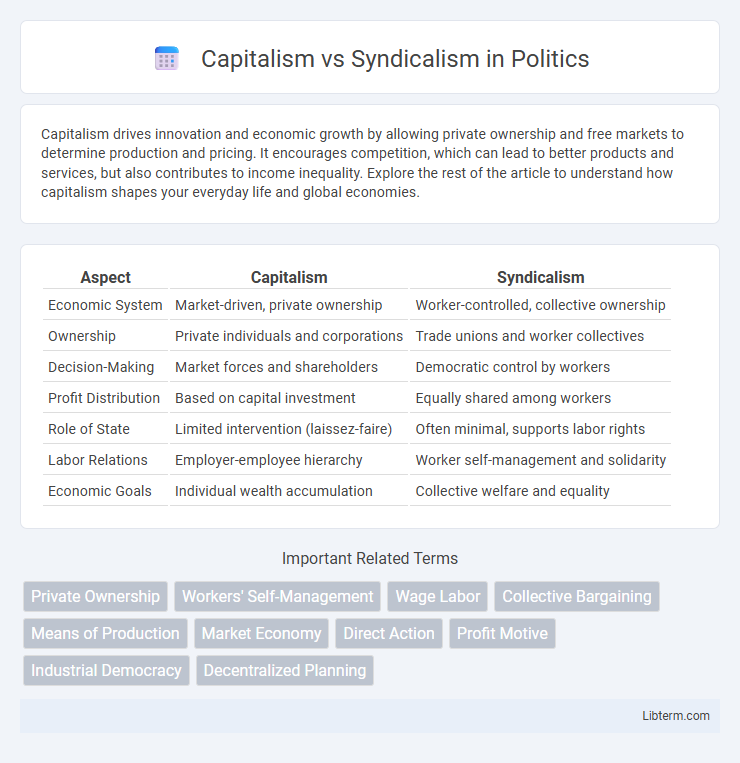Capitalism drives innovation and economic growth by allowing private ownership and free markets to determine production and pricing. It encourages competition, which can lead to better products and services, but also contributes to income inequality. Explore the rest of the article to understand how capitalism shapes your everyday life and global economies.
Table of Comparison
| Aspect | Capitalism | Syndicalism |
|---|---|---|
| Economic System | Market-driven, private ownership | Worker-controlled, collective ownership |
| Ownership | Private individuals and corporations | Trade unions and worker collectives |
| Decision-Making | Market forces and shareholders | Democratic control by workers |
| Profit Distribution | Based on capital investment | Equally shared among workers |
| Role of State | Limited intervention (laissez-faire) | Often minimal, supports labor rights |
| Labor Relations | Employer-employee hierarchy | Worker self-management and solidarity |
| Economic Goals | Individual wealth accumulation | Collective welfare and equality |
Introduction to Capitalism and Syndicalism
Capitalism is an economic system characterized by private ownership of the means of production, profit-driven markets, and minimal government intervention, promoting competition and individual entrepreneurship. Syndicalism, rooted in labor union activism, advocates for the collective ownership and management of industries by workers through direct action and democratic control. Both systems propose distinct approaches to economic organization, with capitalism emphasizing market mechanisms and syndicalism focusing on worker empowerment and industrial democracy.
Historical Origins and Evolution
Capitalism emerged during the late Middle Ages and Renaissance, rooted in private property, free markets, and profit-driven enterprise, evolving through the Industrial Revolution into a dominant global economic system. Syndicalism arose in the late 19th and early 20th centuries as a radical labor movement advocating for worker control of production and direct action, largely in response to industrial capitalism's inequalities. The evolution of syndicalism is closely tied to key historical events such as the French General Strike of 1906 and the rise of trade unions, contrasting with capitalism's expansion through colonialism and global trade networks.
Core Principles and Philosophies
Capitalism centers on private ownership of means of production, market-driven economies, and profit maximization, emphasizing individual freedom and competition. Syndicalism advocates for worker control over industries through direct action, collective bargaining, and democratic management, aiming to replace capitalist structures with decentralized, labor-managed organizations. The core philosophical divide lies in capitalism's prioritization of individual capital accumulation versus syndicalism's focus on collective ownership and equitable distribution of resources.
Economic Structures Compared
Capitalism is characterized by private ownership of the means of production and market-driven resource allocation, promoting competition and profit maximization. Syndicalism advocates for worker-controlled cooperatives and direct management of industries through trade unions, emphasizing collective ownership and democratic decision-making. These contrasting economic structures influence wealth distribution, labor relations, and the role of state intervention in economic activities.
Role of Labor and Ownership
Capitalism emphasizes private ownership of production means, with labor primarily viewed as a commodity sold in the market, where workers have limited control over decision-making. Syndicalism advocates for worker control of production through labor unions or cooperatives, aiming to abolish private ownership in favor of collective management and direct labor involvement. This fundamental difference shapes economic power distribution, with capitalism concentrating ownership and syndicalism promoting equitable control by labor forces.
Wealth Distribution and Social Equity
Capitalism prioritizes wealth accumulation through private ownership and market competition, often leading to significant income disparities and concentrated capital among elites. Syndicalism emphasizes collective ownership of production means, promoting equitable wealth distribution and empowering workers by directly controlling economic decisions. While capitalism drives innovation and growth, syndicalism focuses on reducing social inequality by democratizing economic power and resources.
Market Mechanisms vs. Collective Decision-Making
Capitalism relies on market mechanisms where prices and production are determined by supply and demand, promoting competition and individual profit incentives. Syndicalism emphasizes collective decision-making through worker-controlled organizations, prioritizing equitable distribution of resources and direct management of industries by labor groups. Market efficiency in capitalism contrasts with syndicalism's focus on social welfare and democratic workplace governance.
Advantages and Criticisms of Capitalism
Capitalism promotes economic growth through private ownership, competitive markets, and profit incentives that drive innovation and efficiency. Critics argue capitalism fosters income inequality, exploitation of labor, and environmental degradation due to its focus on profit maximization. Despite these criticisms, capitalism remains a dominant economic system by enabling consumer choice and attracting investment.
Advantages and Criticisms of Syndicalism
Syndicalism promotes worker control over production through direct democratic management and collective ownership, reducing income inequality and enhancing workplace democracy. However, critics argue that syndicalism may lead to inefficiencies, lack of innovation, and difficulties coordinating large-scale economies due to decentralized decision-making. The emphasis on labor unions can also result in conflicts between factions and potential exclusion of non-unionized workers from economic participation.
Modern Relevance and Future Perspectives
Capitalism drives innovation through competitive markets and private ownership, fostering economic growth and technological advancement in today's global economy. Syndicalism emphasizes worker control and cooperative management, appealing to movements advocating for labor rights and equitable wealth distribution amid rising income inequality. Future perspectives suggest hybrid models incorporating sustainable capitalism with syndicalist principles could address social justice challenges while maintaining economic efficiency.
Capitalism Infographic

 libterm.com
libterm.com